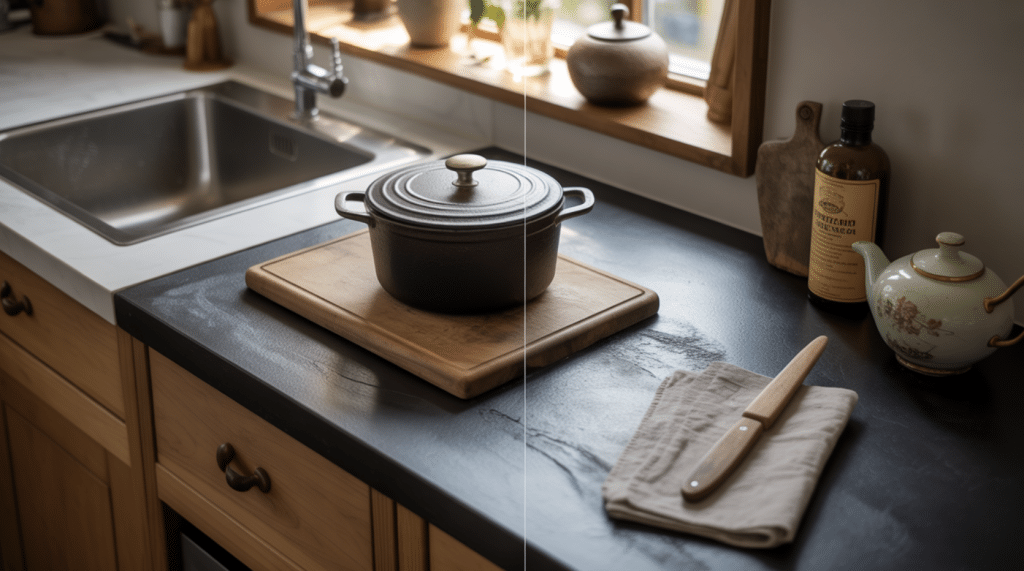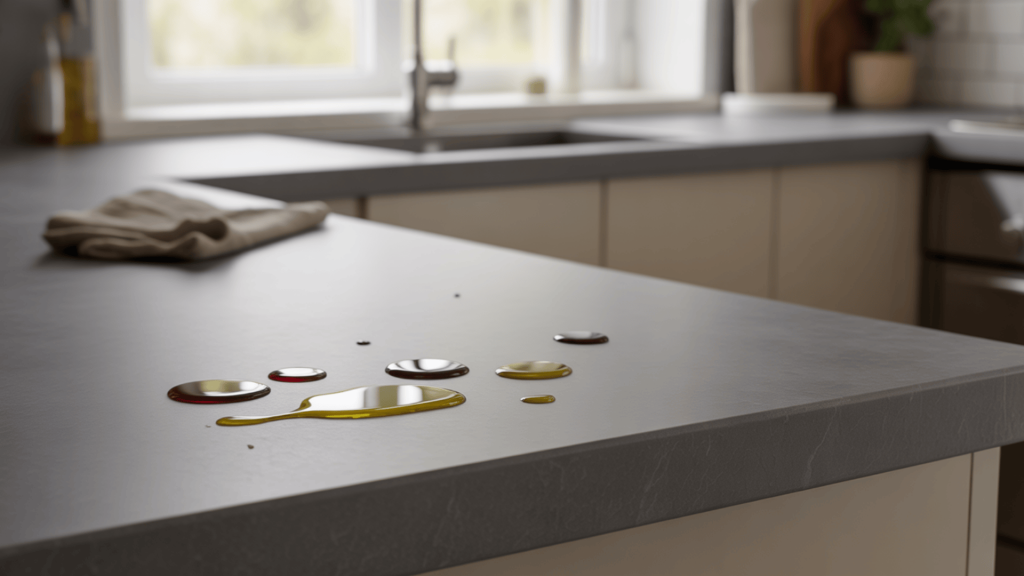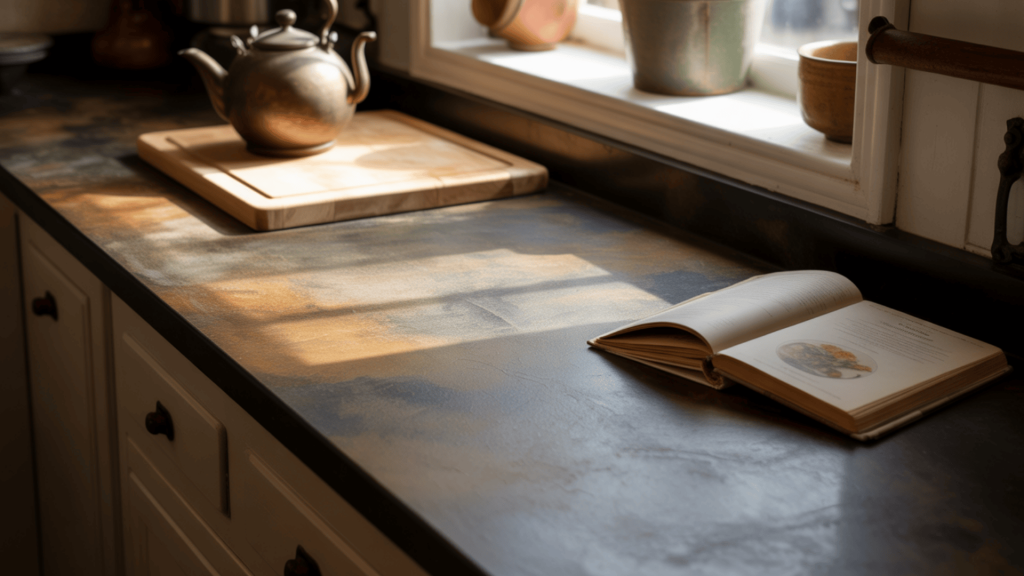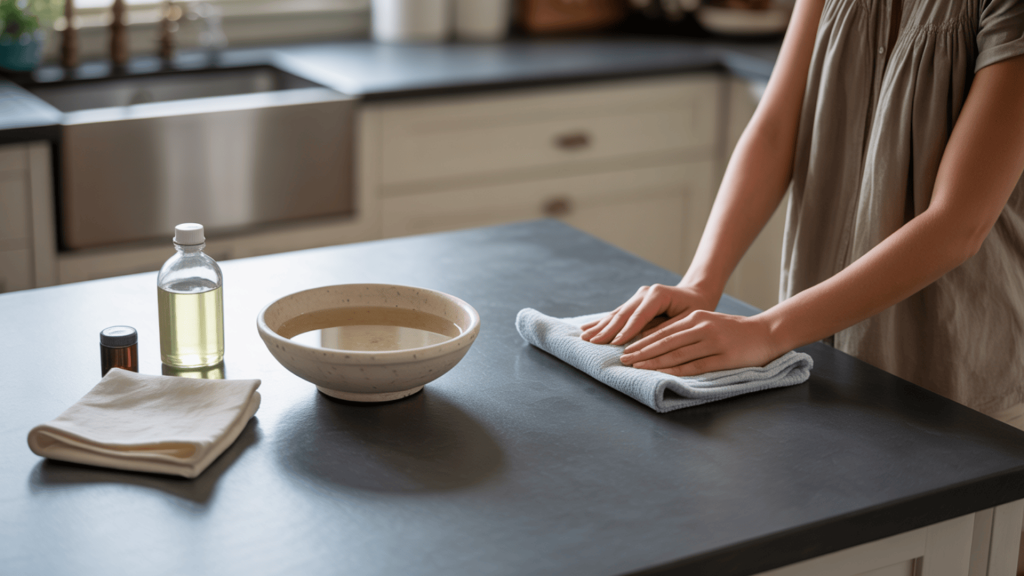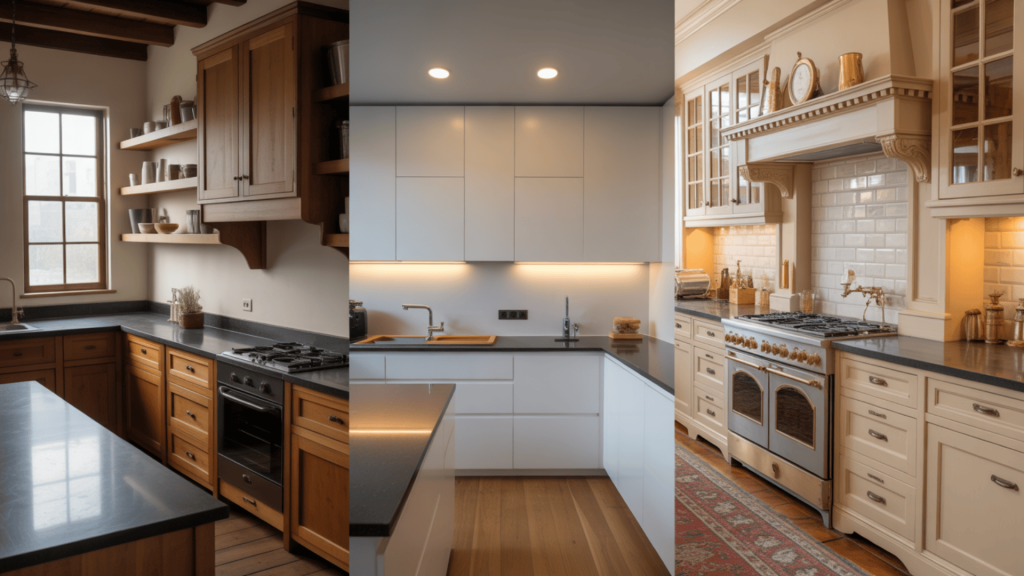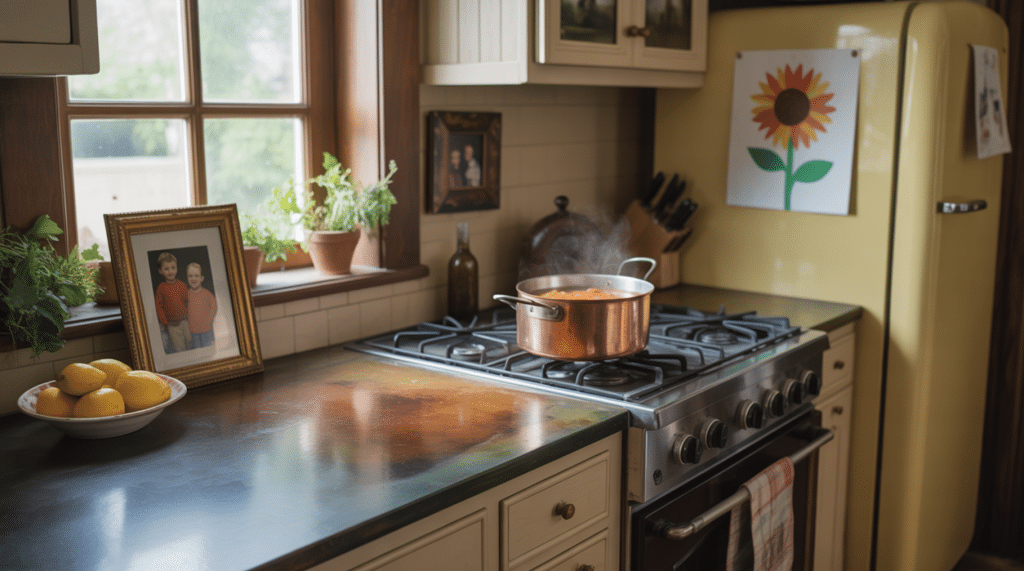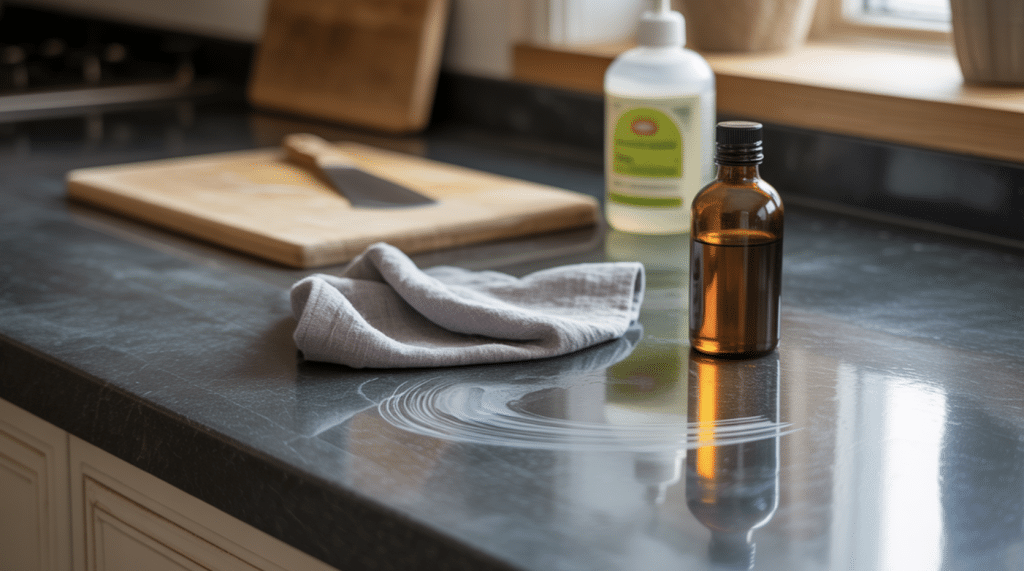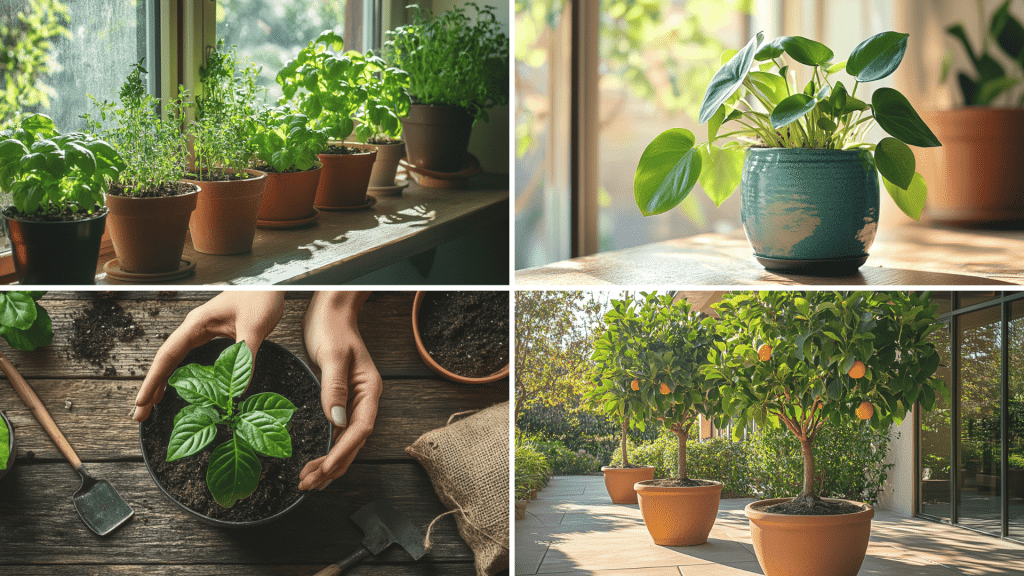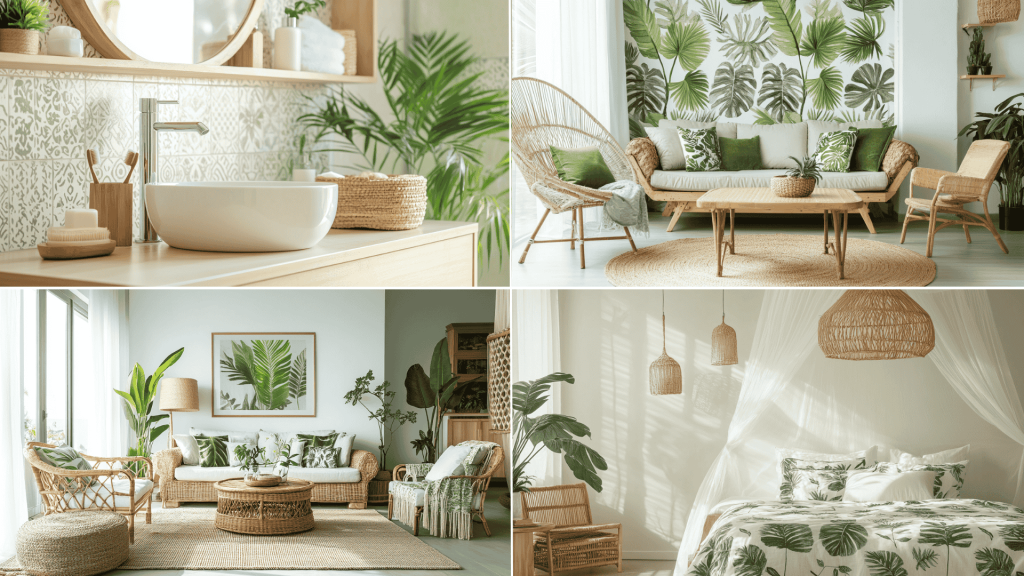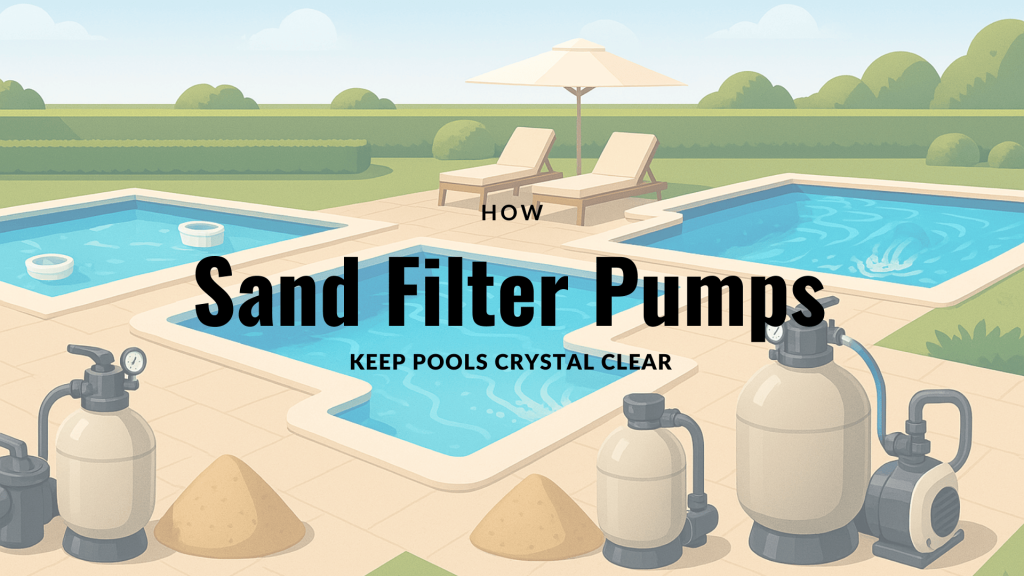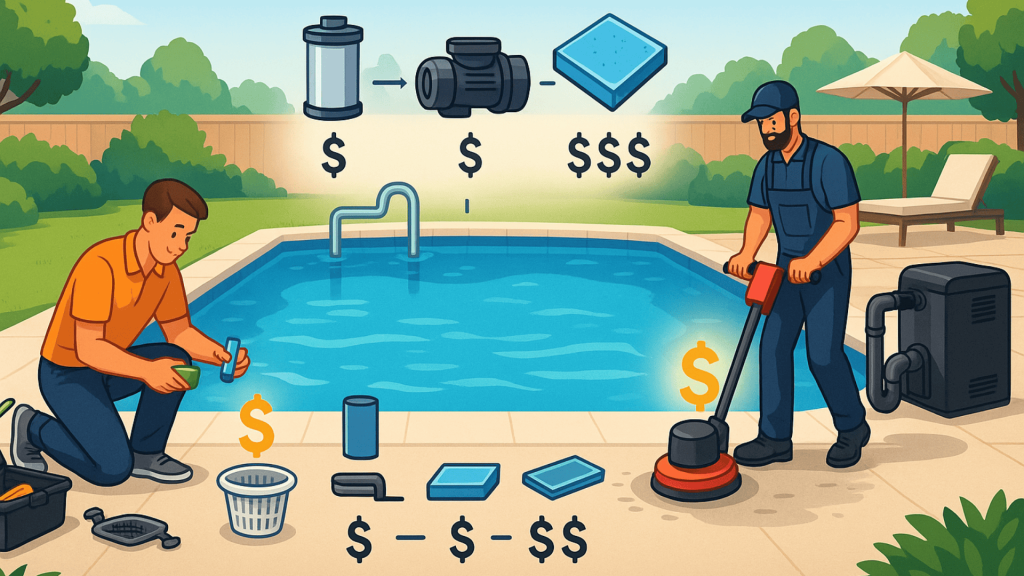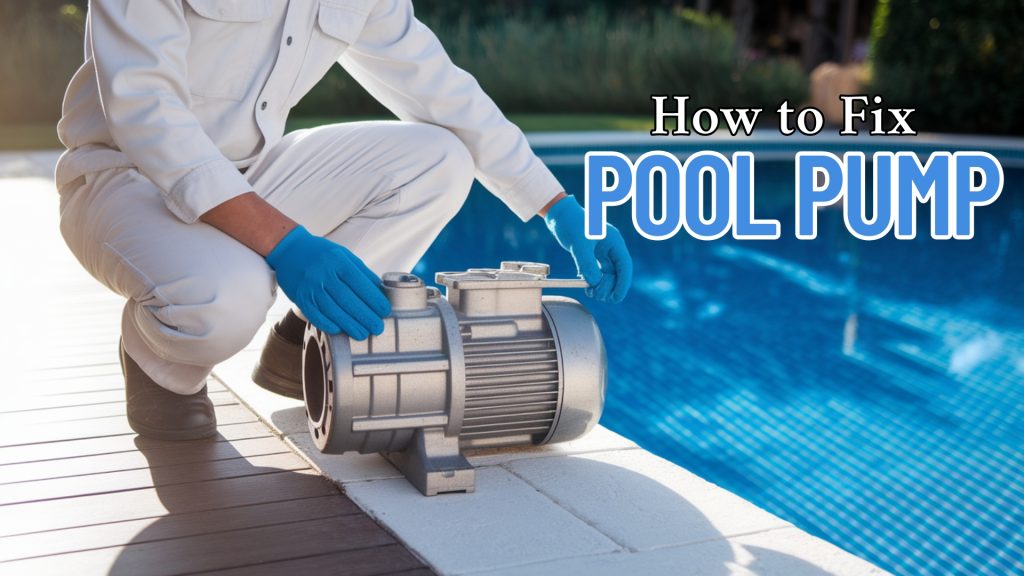Looking for kitchen counters that handle hot pots, resist stains, and bring timeless style?
Soapstone might be your answer.
This natural stone option stands apart from typical granite and quartz with its soft feel and unique aging process.
But like any kitchen choice, soapstone comes with both good points and challenges worth knowing before you buy.
From its heat-handling powers to its scratch concerns, understanding what makes soapstone special helps you decide if it belongs in your home.
We’ll walk through what makes soapstone shine and where it falls short so you can make the right call for your kitchen, style, and cooking habits.
What Are the Pros and Cons of Soapstone Countertops?
Thinking about soapstone for your kitchen update?
This natural stone option brings both strong points and some challenges worth knowing before you buy.
Pros:
- Soapstone stands out for its heat handling—you can put hot pots directly on it without damage
- Many homeowners love that it needs less upkeep than other stone options
- Fits perfectly in country-style or old-fashioned kitchen designs
- Gives spaces a warm, lived-in look that many find appealing
- Over time, it develops a worn-in patina that makes kitchens more welcoming
Cons:
- These countertops can get scratched more easily than granite or quartz
- You’ll find mostly gray and black shades, with few color choices
- Need routine oiling to keep their look
- Costs more upfront than some other options
- Weigh more than many alternatives, requiring strong cabinet support
So, should you pick soapstone?
It depends on your cooking habits, how much upkeep you’re willing to do, and if you like its unique look.
For those who cook often and want something that can handle heat without special care, soapstone might be your perfect match.
Top Benefits of Soapstone Countertops You’ll Love
Soapstone counters bring many perks to your kitchen that other materials can’t match.
This natural stone option stands out for good reasons that make many homeowners choose it over more common choices.
When you pick soapstone for your kitchen, you’re getting a material that has stood the test of time in homes for generations.
1. Natural Heat Protection
One of the biggest wins with soapstone is how it handles heat.
You can put hot pots and pans straight from the stove or oven onto the surface without worry.
This makes cooking and baking much easier since you don’t need to hunt for trivets.
This heat handling comes from soapstone’s dense makeup and high talc content.
The same traits that make it perfect for fireplaces and wood stoves make it ideal for busy cooks who don’t want to worry about damaging their counters.
2. No Staining or Sealing Needed
Unlike many natural stones, soapstone doesn’t soak up liquids.
This means red wine, coffee, olive oil, and other common kitchen spills just sit on top instead of sinking in and causing stains.
This non-porous nature means you never need to seal soapstone.
While granite and marble need regular sealing to prevent damage, soapstone stays protected naturally.
This cuts down on maintenance and worry about keeping up with sealing schedules.
3. Ages With Character
The way soapstone changes over time draws many people to it.
It develops a rich, dark look with use, creating a lived-in feel that many find appealing.
This natural aging process gives your kitchen a warm, established look that can’t be rushed.
Each soapstone counter tells the story of your kitchen through its unique pattern of darkening and gentle wear.
Unlike materials that try to look perfect forever, soapstone embraces change and often looks better with age.
4. Simple Cleaning and Care
Day-to-day care for soapstone couldn’t be much easier.
Basic soap and water handle most cleaning needs.
You don’t need special stone cleaners or harsh chemicals to keep it looking good.
The mineral oil treatment that helps build the dark patina is simple to apply.
Just wipe it on with a cloth every few weeks at first, then less often as the stone matures.
This easy care routine makes soapstone perfect for busy households.
Major Drawbacks of Soapstone You Should Consider
Before jumping into a soapstone purchase, you should know about some downsides that might affect your choice.
The softness that makes soapstone easy to work with also means it can get scratched.
Knife marks, dropped pots, or even dragging heavy items can leave marks on the surface.
While these can be sanded out, they do happen more often than with harder stones.
Ongoing Care Needs
Soapstone needs regular oiling, especially in the first year.
This helps the stone darken and build its special worn-in look. For some, this simple task is worth it.
Others might find it too much work compared to lower-maintenance options.
If you want lots of color choices, soapstone might let you down.
It mainly comes in shades of gray, black, and sometimes green.
When soapstone ages, it doesn’t always darken at the same rate across the whole surface.
Some spots might change color faster than others, creating an uneven look that takes time to even out.
Cost Factors
The price tag on soapstone runs higher than many other choices.
Expect to pay between $55 and $150 per square foot with installation.
This puts it in the premium countertop range.
Soapstone weighs more than many other options.
Your cabinets need to be strong enough to support this weight, and you’ll want skilled installers who know how to work with this material.
Soapstone vs. Other Countertop Materials
When shopping for countertops, it helps to see how soapstone compares to popular choices like granite, quartz, and marble.
Each material brings something different to your kitchen, with its own mix of good and not-so-good points.
| FEATURE | SOAPSTONE | GRANITE | QUARTZ | MARBLE |
|---|---|---|---|---|
| Heat Handling | Can place hot pots directly on the surface | Can crack with sudden heat changes | Can be damaged by heat | Can be damaged by heat |
| Stain Fighting | Naturally stain-proof without sealing | Needs sealing to prevent stains | Very stain-proof | Stains easily, needs sealing |
| Scratch Protection | Can be scratched, but fixable | Very scratch-proof | Very scratch-proof | Can scratch and etch |
| Maintenance | Monthly oiling at first, then less often | Needs resealing yearly | Almost no maintenance | Regular sealing and careful cleaning |
| Price Range | $55-$150 per square foot | $40-$100 per square foot | $50-$120 per square foot | $60-$180 per square foot |
The right counter material depends on your cooking habits, how much care you’re willing to do, and what look you want.
Choose soapstone if you want a natural material with character that grows over time, heat protection for hot pots and pans, freedom from worrying about stains, and a look that works in various kitchen styles.
Soapstone stands out most for its heat handling and natural stain fighting.
No other common countertop material can match how it handles both hot items and spills without special treatment.
For busy kitchens where cooking happens often, these traits can make soapstone worth the extra cost and care it needs.
Design Appeal and Aesthetic Versatility
Soapstone brings a unique look to kitchens that many homeowners find appealing.
Its natural beauty works well in many home styles, from old-world to modern spaces.
The simple, understated look of soapstone makes it a good match for kitchens of all types.
Unlike flashy or glossy options, soapstone has a quiet beauty that can work as either a focal point or a supporting player in your kitchen design.
1. Fits Many Kitchen Styles
In country or farm-style kitchens, soapstone feels right at home. Its worn-in look pairs perfectly with wooden cabinets, open shelving, and simple hardware.
The natural stone brings warmth to these casual cooking spaces.
For modern kitchens, soapstone offers clean lines and a matte finish that fits well with sleek cabinets and simple designs.
The lack of busy patterns makes it work well in spaces focused on basic forms and clean looks.
Classic kitchens also benefit from soapstone’s timeless appeal.
Its look has stayed in style for hundreds of years, making it a safe choice that won’t quickly feel outdated or trendy.
2. Color Matching Options
While soapstone comes in limited shades itself, it works well with many color schemes.
Its gray to black tones create a neutral base that lets cabinet colors stand out.
White cabinets create a strong contrast with dark soapstone, making both elements pop.
This classic black and white look stays stylish through changing trends.
Colored cabinets in green, blue, or even yellow can pair beautifully with soapstone’s muted tones.
The stone’s simple look helps balance bolder cabinet color choices without fighting for attention.
3. Aging and Changing With You
One of soapstone’s most unique traits is how it changes over time.
Unlike materials that try to stay looking new forever, soapstone builds character with use.
This changing nature means your kitchen can grow and shift with your family.
The marks and patina that build up tell the story of meals cooked and memories made.
For many homeowners, this personal touch makes soapstone special.
The way soapstone darkens with age often makes it look better as years pass.
While some materials look worn out with time, soapstone simply looks more settled and rich, much like good wood furniture gains beauty with age.
Care, Maintenance, and Longevity Tips
Taking care of soapstone doesn’t require complex routines or special products.
With some basic knowledge and simple habits, your soapstone counters can last for generations while looking their best.
Unlike many other high-end countertop materials, soapstone forgives most common kitchen mishaps.
Still, knowing how to properly care for it helps maintain its beauty and extend its already impressive lifespan.
Daily Care and Protection
For everyday cleaning, plain water and mild dish soap work perfectly.
Just wipe the surface with a soft cloth or sponge to remove food bits, spills, and normal kitchen messes.
Keep cutting boards handy for food prep.
Though knife marks can be sanded out, preventing them in the first place saves you work later on.
Using cutting boards is an easy way to keep your counters looking better longer.
If you notice water spots or light stains, they’re likely just on the mineral oil layer, not in the stone itself.
A quick wipe with mineral oil will usually make them disappear, showing off soapstone’s natural stain-fighting ability.
Long-Term Maintenance
The mineral oil treatment is the main upkeep soapstone needs.
For new installations, apply food-grade mineral oil every few weeks for the first year.
This helps the stone develop its famous dark patina evenly across the surface.
After the first year, you can usually reduce oiling to once every few months or whenever the stone starts looking dry or lighter in spots.
For scratches that do occur, fine sandpaper (220-grit or higher) can smooth them away. Just sand gently in the affected area, then apply mineral oil to blend it with the rest of the counter.
This quick fix is much easier than the repair methods needed for other stone types.
Many soapstone counters stay in service for 50 years or more with basic care.
The fact that 100-year-old soapstone sinks and counters still function perfectly in historic homes speaks to this material’s staying power.
The Bottom Line
Soapstone brings unique benefits that many other countertop materials simply can’t match.
Its heat tolerance, natural stain fighting, and changing beauty make it worth considering for your kitchen update.
Yes, it needs some care and comes with a higher price tag, but many homeowners find these small trade-offs worth it for counters that tell the story of your home over time.
The right choice comes down to your cooking style, maintenance comfort, and what look you want for your space.
With proper care, soapstone rewards you with decades of service and a kitchen that feels both practical and full of character.

